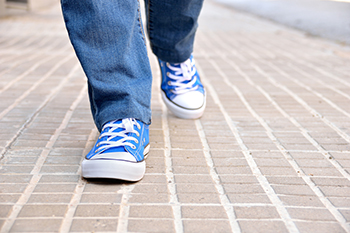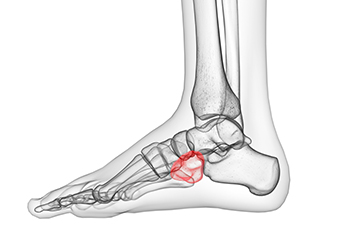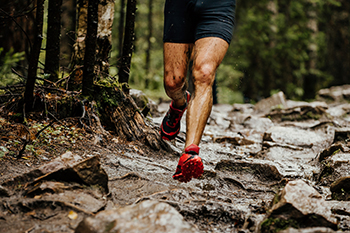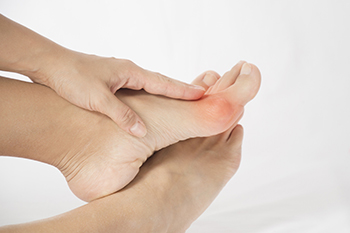
A walking abnormality is when the walking gait is abnormal in some way. Diseases, injuries, or genetic factors may contribute to an abnormal walking pattern. Altered walking can further cause harm to muscles, bones, and nerves in the lower extremities and rest of the body. Depending on the severity of the walking abnormality, and how long it endures, different treatments are suggested. Walking abnormally can present itself as walking with the head and neck thrust forward, and walking with the legs bent. Additionally, it may be evident as the knees and thighs cross over each other in a scissor-like fashion, or the feet may drag while walking. Even a limp is considered to be a walking abnormality. If you find that your gait is altered and you do not know why, it is suggested that you visit a podiatrist for an examination and diagnosis so you can be on the road to recovery.
If you have any concerns about your feet, contact one of our podiatrists from Farah Podiatry Associates. Our doctors can provide the care you need to keep you pain-free and on your feet.
Biomechanics in Podiatry
Podiatric biomechanics is a particular sector of specialty podiatry with licensed practitioners who are trained to diagnose and treat conditions affecting the foot, ankle and lower leg. Biomechanics deals with the forces that act against the body, causing an interference with the biological structures. It focuses on the movement of the ankle, the foot and the forces that interact with them.
A History of Biomechanics
Modern technological improvements are based on past theories and therapeutic processes that provide a better understanding of podiatric concepts for biomechanics. Computers can provide accurate information about the forces and patterns of the feet and lower legs.
Understanding biomechanics of the feet can help improve and eliminate pain, stopping further stress to the foot.
If you have any questions please feel free to contact our office located in Trenton, MI . We offer the newest diagnostic and treatment technologies for all your foot and ankle needs.

The cuboid bone is located on the outside of the foot and is one of seven tarsal bones. Cuboid syndrome occurs when this bone partially dislocates, which can happen from an injury. An ankle sprain may cause the peroneal muscles to put excess pressure on this tarsal bone, leading to pain and discomfort. An effective treatment method may include performing specific types of stretches that can help to loosen tight peroneal muscles. Additionally, the bone may be manipulated back into its normal position, and it may help to pad and tape the foot for extra stability. Many patients find getting a deep tissue massage can relax the calf and peroneal muscle, which can eliminate pressure on the cuboid bone. If you have endured an injury, and have pain on the outside of your foot, it is suggested that you confer with a podiatrist who can properly diagnose and treat cuboid syndrome.
Cuboid syndrome, also known as cuboid subluxation, occurs when the joints and ligaments near the cuboid bone in the foot become torn. If you have cuboid syndrome, consult with one of our podiatrists from Farah Podiatry Associates. Our doctors will assess your condition and provide you with quality foot and ankle treatment.
Cuboid syndrome is a common cause of lateral foot pain, which is pain on the outside of the foot. The condition may happen suddenly due to an ankle sprain, or it may develop slowly overtime from repetitive tension through the bone and surrounding structures.
Causes
The most common causes of cuboid syndrome include:
Symptoms
A common symptom of cuboid syndrome is pain along the outside of the foot which can be felt in the ankle and toes. This pain may create walking difficulties and may cause those with the condition to walk with a limp.
Diagnosis
Diagnosis of cuboid syndrome is often difficult, and it is often misdiagnosed. X-rays, MRIs and CT scans often fail to properly show the cuboid subluxation. Although there isn’t a specific test used to diagnose cuboid syndrome, your podiatrist will usually check if pain is felt while pressing firmly on the cuboid bone of your foot.
Treatment
Just as the range of causes varies widely, so do treatments. Some more common treatments are ice therapy, rest, exercise, taping, and orthotics.
If you have any questions, please feel free to contact our office located in Trenton, MI . We offer the newest diagnostic and treatment technologies for all your foot care needs.

Running on trails requires many precautions that are not needed for other types of exercise or sport. Among the most important considerations is finding the proper footwear. Here are some tips from experts for selecting trail running shoes that can enhance your safety and increase your enjoyment. This type of shoe falls into three categories, including light trails, rugged trails, and off trails. Light trail shoes are made of fairly stiff materials that offer some protection from rocks, but serve well on more groomed trails. Rugged trail shoes are sturdier and have tougher soles that may help to prevent slipping, while providing more stability against foot rotation. They also have thicker exteriors to ward off thorns and brush. Off trail shoes are the most rugged, providing extra protection against rough terrain. They hold up well in bogs, streams and other slippery spots. As with all running footwear, trail running shoes must fit properly, while taking into account the socks that you will wear. For more information on what type of shoes to purchase for trail running, it is suggested that you consult a podiatrist.
Exercising your feet regularly with the proper foot wear is a great way to prevent injuries. If you have any concerns about your feet, contact one of our podiatrists of Farah Podiatry Associates. Our doctors will treat your foot and ankle needs.
How to Prevent Running Injuries
Many common running injuries are caused by overuse and overtraining. When the back of the kneecap starts wearing out and starts causing pain in your knee, this is commonly referred to as runner’s knee. Runner’s knee is a decrease in strength in your quadriceps and can occur if you’re not wearing properly fitted or supporting shoes. To prevent runner’s knee, focusing on hip strengthening is a good idea, as well as strengthening your quads to keep the kneecaps aligned.
What Are Some Causes of Running Injuries?
- One cause of a common running injury is called iliotibial band syndrome.
- Plantar fasciitis is also another common injury.
- Stress fractures can occur from overtraining, lack of calcium, or even your running style.
Best Ways to Prevent Running Injuries
- Wear footwear that fits properly and suits your running needs.
- Running shoes are the only protective gear that runners have to safeguard them from injury.
- Make a training schedule. Adding strengthening exercises as well as regular stretching can help keep you strong and limber and can lessen the possibility of injuries.
- Stretching keeps muscles limber; this will help you gain better flexibility.
If you have any questions please feel free to contact our office located in Trenton, MI . We offer the newest diagnostic and treatment technologies for all your foot and ankle needs.

There is a small percentage of people worldwide who are affected by the foot condition that is known as gout. It is a form of arthritis and can cause debilitating pain and discomfort. Gout occurs due to excess uric acid in the blood. The excess uric acid may be caused by eating foods with large amounts of purines. These can consist of shellfish, red meat, and sugary drinks. Gout may also occur from genetic reasons, and it may be more prevalent among men who are over 40 years old. The abundance of uric acid converts to crystals that lodge in the joints of the big toe, and in addition to the pain, there may be swelling and redness. The range of motion in the toe may be temporarily reduced, and the pain may radiate to the other joints. Gout attacks may be prevented when healthy foods are eaten, including vegetables, whole grain foods, and dairy products that are low in fat. If you suffer from gout, it is strongly suggested that you are under the care of a podiatrist who can help you to manage this condition.
Gout is a foot condition that requires certain treatment and care. If you are seeking treatment, contact one of our podiatrists from Farah Podiatry Associates. Our doctors will treat your foot and ankle needs.
What Is Gout?
Gout is a type of arthritis caused by a buildup of uric acid in the bloodstream. It often develops in the foot, especially the big toe area, although it can manifest in other parts of the body as well. Gout can make walking and standing very painful and is especially common in diabetics and the obese.
People typically get gout because of a poor diet. Genetic predisposition is also a factor. The children of parents who have had gout frequently have a chance of developing it themselves.
Gout can easily be identified by redness and inflammation of the big toe and the surrounding areas of the foot. Other symptoms include extreme fatigue, joint pain, and running high fevers. Sometimes corticosteroid drugs can be prescribed to treat gout, but the best way to combat this disease is to get more exercise and eat a better diet.
If you have any questions please feel free to contact our office located in Trenton, MI . We offer the newest diagnostic and treatment technologies for all your foot and ankle needs.

Bunions are uncomfortable bony bumps that can develop on the side of the feet. Typically, bunions form on the outside of the foot near the big toe. However, smaller bunions may also develop on the outside of the foot near the pinky toe. When an individual ages, they may become increasingly susceptible to foot conditions, such as bunions. Many senior adults who have bunions often wonder whether bunion surgery is a suitable option for them. The answer is slightly complicated and dependent on each individual patient. It is important to note that an older individual can undergo a surgery to address their bunions. However, it is equally important to note that several age-related conditions may make bunion surgery less feasible. For example, diabetes, obesity, and weak bone health may increase the risks associated with surgery for bunions. If you are a senior living with bunions and would like to inquire about possible surgical procedures, it is recommended that you consult a podiatrist today.
If you are suffering from bunions, contact one of our podiatrists of Farah Podiatry Associates. Our doctors can provide the care you need to keep you pain-free and on your feet.
What Is a Bunion?
A bunion is formed of swollen tissue or an enlargement of boney growth, usually located at the base joint of the toe that connects to the foot. The swelling occurs due to the bones in the big toe shifting inward, which impacts the other toes of the foot. This causes the area around the base of the big toe to become inflamed and painful.
Why Do Bunions Form?
Genetics – Susceptibility to bunions are often hereditary
Stress on the feet – Poorly fitted and uncomfortable footwear that places stress on feet, such as heels, can worsen existing bunions
How Are Bunions Diagnosed?
Doctors often perform two tests – blood tests and x-rays – when trying to diagnose bunions, especially in the early stages of development. Blood tests help determine if the foot pain is being caused by something else, such as arthritis, while x-rays provide a clear picture of your bone structure to your doctor.
How Are Bunions Treated?
If you have any questions, please feel free to contact our office located in Trenton, MI . We offer the newest diagnostic and treatment technologies for all your foot care needs.